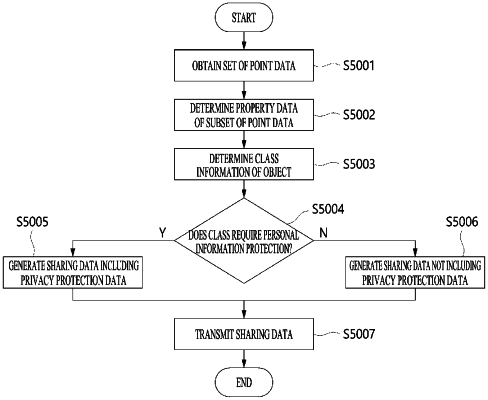| CPC B60W 60/001 (2020.02) [G06F 21/6254 (2013.01); G06F 21/6263 (2013.01); G06V 20/56 (2022.01); G08G 1/205 (2013.01); H04L 63/0421 (2013.01); H04W 4/38 (2018.02); H04W 4/40 (2018.02)] | 13 Claims |

|
1. A method for sharing Light Detection and Ranging (LiDAR) data of a first device with a second device, comprising:
obtaining, by a controller in the first device, a set of point data from at least one of one or more LiDAR devices located on a third device external to the first device, wherein the set of point data comprises a first subset of point data corresponding to an object located in a field of view of the at least one of the one or more LiDAR devices, wherein each of the set of point data includes a position coordinate and an intensity value, and wherein the position coordinate is obtained at least partially based on a distance to each point data of the set of point data;
selecting, by the controller, the first subset of point data from the set of point data;
obtaining, by the controller, a first property data based on the first subset of point data, wherein the first property data includes class information of the object and a distance of the object;
generating, by the controller, a first determination result indicating whether or not the object corresponds to a human based on the class information;
generating, by the controller, a second determination result indicating whether or not the distance of the object is less than a first predetermined distance;
in response to the first determination result indicating that the object corresponds to a human and the second determination result indicating that the distance of the object is less than the first predetermined distance, processing, by the controller, the set of point data to generate a first privacy protected subset data corresponding to the first subset of point data, the first privacy protected subset data not including first privacy information of the object; and
transmitting, by the controller, selectively one of the first subset of point data or the first privacy protected subset data to the second device at least partially based on at least one of the first determination result or the second determination result such that;
the first privacy protected subset data is transmitted and the first subset of point data is not transmitted in response to the first determination result indicating that the object corresponds to a human and the second determination result indicating that the distance of the object is less than the first predetermined distance, or
the first subset of point data is transmitted and the first privacy protected subset data is not transmitted in response to the first determination result indicating that the object does not correspond to a human or the second determination result indicating that the distance of the object is not less than the first predetermined distance.
|